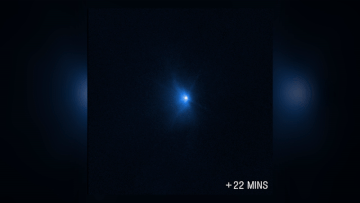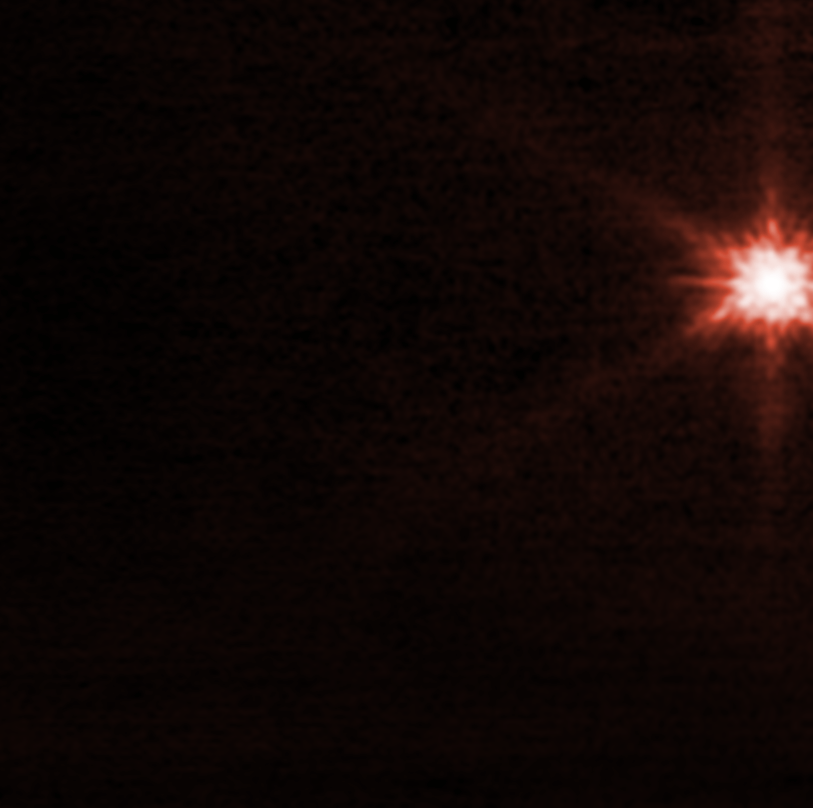DART asteroid collision captured by Hubble and James Webb telescopes
The collision made the asteroid three times as bright

The spectacular moment NASA’s Double Asteroid Redirection Test (DART) craft smashed into a distant asteroid has been captured by the James Webb Space Telescope (JWST) and the Hubble Space Telescope — and the footage is incredible.
The DART spacecraft smashed into the asteroid Dimorphos, which is 7 million miles (11 million kilometers) from Earth, at 7:14 p.m. ET on Monday (Sept. 26), marking humanity's first attempt to test its planetary defense system by altering an asteroid's trajectory.
The JWST studied the collision over a timeframe of roughly five hours, snapping 10 images, while Hubble captured 45 images of the moments immediately before and after the impact. Stitched together, the pictures show wispy plumes of material suddenly spiking out from Dimorphos after the DART crash, with the asteroid becoming three times as bright for eight hours following the event.
Related: Watch NASA's DART spacecraft hit 'bullseye' by smashing into an asteroid
“We’ve been looking forward to the DART impact for over 17 years, and it’s so exciting to see it through the eyes of the greatest space observatories Webb and Hubble. These images provide us with clues of what happened in the first hours after impact, and clearly there is much more happening than we had foreseen,” Ian Carnelli, the manager for the European Space Agency’s upcoming Hera mission, said in a statement. Hera will launch in 2024 to study the aftermath of the impact in 2026.

“It makes the Hera mission even more important now as we absolutely need to get up close to Didymos to understand in full detail what really happened,” Carnelli added. Didymos is a 1,280-feet-wide (390 meters) asteroid that is the larger partner of the 525-feet-wide (160 m) Dimorphos.
The 1,210-pound (550 kilograms) DART craft, a squat, cube-shaped probe consisting of sensors, an antenna, an ion thruster and two 28-foot-long (8.5 m) solar arrays, smashed into Dimorphos while traveling at roughly 14,540 mph (23,400 km/h). The goal of the probe, which crashed into Dimorphos just 56 feet (17 m) from its exact center, was to slow the asteroid’s orbit around the larger Didymos.
Sign up for the Live Science daily newsletter now
Get the world’s most fascinating discoveries delivered straight to your inbox.
Scientists expected the test to slow Dimorphos down by around 1% and bring it into closer orbit with Didymos. The mission will be considered a success if it slows Dimorphos' 12-hour orbit by 73 seconds, but the real change could be by as much as 10 minutes.
Two other videos were also taken of the crash’s aftermath by two terrestrial telescopes. The Hawaiian Asteroid Terrestrial-impact Last Alert System and one of Las Cumbres Observatory's South African telescopes both captured videos of the impact — showing a bright puff of dust and rubble plume from Dimorphos at the moment of impact.
Closer to the space rock, scientists will get a better picture of the impact's immediate aftermath by turning to the Italian space agency's LICIACube — a smaller "cubesat" spacecraft that split from DART on Sept. 11. Now orbiting Dimorphos at a distance of 34 miles (55 km), LICIACube has already begun beaming photos back to Earth of how the asteroid's trajectory has been changed and how the collision caused material to explode outwards following the impact. LICIACube’s observations will be supplemented by more from Hubble and the JWST over the coming weeks.
All of this will enable scientists to piece together a picture of the kind of force it may take to divert future asteroids from smashing into our planet with deadly consequences.
Originally published on Live Science.

Ben Turner is a U.K. based staff writer at Live Science. He covers physics and astronomy, among other topics like tech and climate change. He graduated from University College London with a degree in particle physics before training as a journalist. When he's not writing, Ben enjoys reading literature, playing the guitar and embarrassing himself with chess.









